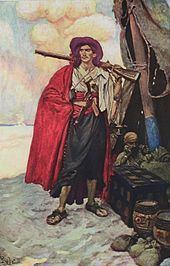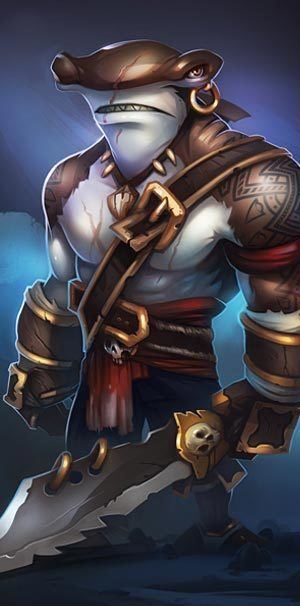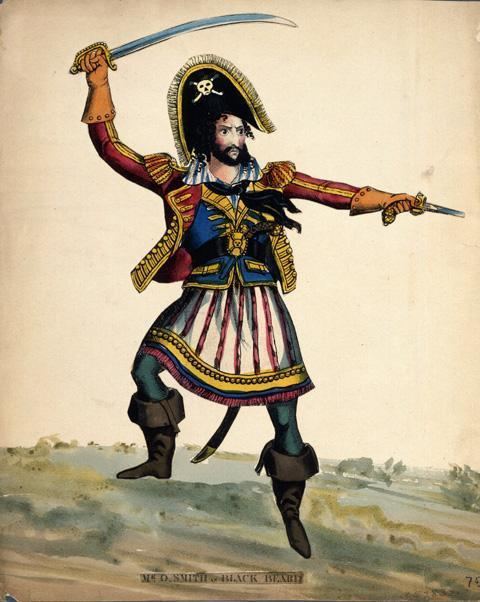 | ||
Buccaneers were pirates of the Caribbean Sea who challenged Spanish hegemony on the region by attacking ships and sacking coastal settlements during the 17th and 18th centuries. Before long, they became a threat to non-Spanish settlements as well, and the target of anti-piracy crusades. Today the idea of a buccaneer plays a role similar to pirate. Original buccaneer crews, however, were larger, localized to the Caribbean region, and more apt to attack well-defended ports than pirates who sailed to the Indian Ocean on the Pirate Round of the late 17th century.
Contents
- Etymology
- History
- Legal status
- Lifestyle
- Debates about sexuality
- Naval
- Land
- Downturn
- Punishments
- In literature
- References

Etymology

The term buccaneer derives from the Caribbean Arawak word buccan, a wooden frame on which Tainos and Caribs slowly roasted or smoked meat, commonly manatee. From it derived the French word boucane and hence the name boucanier for French hunters who used such frames to smoke meat from feral cattle and pigs on Hispaniola (now Haiti and the Dominican Republic). English colonists anglicised the word boucanier to buccaneer.
History

About 1630, French interlopers were driven away from the island of Hispaniola and fled to nearby Tortuga. The Spaniards also tried to drive them out of Tortuga, but the buccaneers were joined by many more French, Dutch, and English adventurers who turned to piracy. They set their eyes on Spanish shipping, generally using small craft to attack galleons in the vicinity of the Windward Passage. With the support and encouragement of rival European powers, they became strong enough to sail for the mainland of Spanish America and sacked cities.

English settlers occupying Jamaica began to spread the name buccaneers with the meaning of pirates. The name became universally adopted later in 1684 when the first English translation of Alexandre Exquemelin's book The Buccaneers of America was published.
Viewed from London, buccaneering was a low-budget way to wage war on England's rival, Spain. So, the English crown licensed buccaneers with letters of marque, legalizing their operations in return for a share of their profits. The buccaneers were invited by Jamaica's Governor Thomas Modyford to base ships at Port Royal. The buccaneers robbed Spanish shipping and colonies, and returned to Port Royal with their plunder, making the city the most prosperous in the Caribbean. There even were Royal Navy officers sent to lead the buccaneers, such as Christopher Myngs. Their activities went on irrespective of whether England happened to be at war with Spain or France.
Among the leaders of the buccaneers were two Frenchmen, Jean-David Nau, better known as François l'Ollonais, and Daniel Montbars, who destroyed so many Spanish ships and killed so many Spaniards that he was called "the Exterminator".
Another noted leader was a Welshman named Henry Morgan, who sacked Maracaibo, Portobello, and Panama City, stealing a huge amount from the Spanish. Morgan became rich and went back to England, where he was knighted by Charles II.
In the 1690s, the old buccaneering ways began to die out, as European governments began to discard the policy of "no peace beyond the Line." Buccaneers were hard to control; some even embroiled their colonies in unwanted wars; notably, at the 1697 joint French-buccaneer siege of Cartagena, led by Bernard Desjean, Baron de Pointis, the buccaneers and the French regulars parted on extremely bitter terms. Less tolerated by local Caribbean officials, buccaneers increasingly turned to legal work or else joined regular pirate crews who sought plunder in the Indian Ocean, the east coast of North America, or West Africa as well as in the Caribbean.
Legal status
The status of buccaneers as pirates or privateers was ambiguous. As a rule, the buccaneers called themselves privateers, and many sailed under the protection of a letter of marque granted by British, French or Dutch authorities. For example, Henry Morgan had some form of legal cover for all of his attacks, and expressed great indignation at being called a "corsair" by the governor of Panama. Nevertheless, these rough men had little concern for legal niceties, and exploited every opportunity to pillage Spanish targets, whether or not a letter of marque was available. Many of the letters of marque used by buccaneers were legally invalid, and any form of legal paper in that illiterate age might be passed off as a letter of marque. Furthermore, even those buccaneers who had valid letters of marque often failed to observe their terms; Morgan's 1671 attack on Panama, for instance, was not at all authorized by his commission from the governor of Jamaica. The legal status of buccaneers was still further obscured by the practice of the Spanish authorities, who regarded them as heretics and interlopers, and thus hanged or garroted captured buccaneers entirely without regard to whether their attacks were licensed by French or English monarchs.
Simultaneously, French and English governors tended to turn a blind eye to the buccaneers' depredations against the Spanish, even when unlicensed. But as Spanish power waned toward the end of the 17th century, the buccaneers' attacks began to disrupt France and England's merchant traffic with Spanish America, such that merchants who had previously regarded the buccaneers as a defense against Spain now saw them as a threat to commerce, and colonial authorities grew hostile. This change in political atmosphere, more than anything else, put an end to buccaneering.
Lifestyle
A hundred years before the French Revolution, the buccaneer companies were run on lines in which liberty, equality and fraternity were the rule. In a buccaneer camp, the captain was elected and could be deposed by the votes of the crew. The crew, and not the captain, decided whether to attack a particular ship, or a fleet of ships. Spoils were evenly divided into shares; the captain received an agreed amount for the ship, plus a portion of the share of the prize money, usually five or six shares.
Crews generally had no regular wages, being paid only from their shares of the plunder, a system called "no purchase, no pay" by Modyford or "no prey, no pay" by Exquemelin. There was a strong esprit among buccaneers. This, combined with overwhelming numbers, allowed them to win battles and raids. There was also, for some time, a social insurance system guaranteeing compensation for battle wounds at a worked-out scale.
Debates about sexuality
Gay historian Barry R. Burg, of Arizona State University, considering court records and historical writings of 17th-century England and the Caribbean, argued that a variety of 17th-century social circumstances produced men rejecting the landed lifestyle for the company of men aboard ship, and that something akin to modern situational sexuality existed, behaviour analogous to homosexuality in the warrior classes of ancient Greece and Japan; he concludes, controversially, that pirates engaged almost exclusively in homosexual activity.
The late University of Connecticut historian Hans Turley, a professor of English and a specialist in gay and lesbian studies, in discussing Burg's work, concluded, as described in review, that there is "surprisingly scant direct evidence that [pirate sexual activity] was also homosexual," and such scant historical evidence in general that "we can't speak with real authority about the pirate at all"; As Paul Hallam notes in his book of literary criticism, The Book of Sodom, "There's scarcely any starting point for Burg's speculations on widespread buccaneer buggery, [as] few pirates kept notes." That being the case, Turley is nevertheless described by John Strausbaugh as seeming to accept the premise of their homosexual activity as" obvious and a given", though without directly saying so.
US Naval officer, pirate researcher and author Benerson Little suggests Burg's view is "extremely speculative" and has dismissed many of the theories Burg proposed from his research. Post anarchist author Peter Lamborn Wilson goes further and openly criticizes Burg for, "applying late 19th-century categories to his analysis of the 16th and 17th century" subject.
Naval
Buccaneers initially used small boats to attack Spanish galleons surreptitiously, often at night, and climb aboard before the alarm could be raised. Buccaneers were expert marksmen and would quickly kill the helmsman and any officers aboard. Buccaneers' reputation as cruel pirates grew to the point that, eventually, most victims would surrender, hoping they would not be killed.
Land
When buccaneers raided towns, they did not sail into port and bombard the defenses, as naval forces typically did. Instead, they secretly beached their ships out of sight of their target, marched overland, and attacked the towns from the landward side, which was usually less fortified. Their raids relied mainly on surprise and speed. The sack of Campeche was considered the first such raid and many others that followed replicated the same techniques including the attack on Veracruz in 1683 and the raid on Cartagena later that same year.
Downturn
While Spanish authorities always viewed buccaneers as trespassers and a threat to their hegemony in the Caribbean basin, over the second half of the 17th century other European powers learned to perceive them in the same way. These new powers have appropriated and secured territories in the area and needed to protect them. Buccaneers who did not settle down on agriculture or some other acceptable business after the so-called Golden Age of Piracy proved a nuisance to them, too. Spanish anti-pirate practices became thus a model for all recently arrived colonial governments. Some expanded them.
Punishments
When caught by anti-pirate English authorities, 17th and 18th century buccaneers meted justice in a summary fashion, and many ended their lives by "dancing the hempen jig", a euphemism for hanging. Public executions were a form of entertainment, and people came out to watch them as they would for a sporting event today. Newspapers reported details such as condemned men's last words, the prayers said by the priests, and descriptions of their final moments in the gallows. In England, most executions took place at Execution Dock on the River Thames in London.
In the cases of more famous prisoners, usually captains, their punishments extended beyond death. Their bodies were enclosed in iron cages (gibbet) (for which they were measured before their execution) and left to swing in the air until the flesh rotted off them—a process that could take as long as two years. The bodies of captains such as William "Captain" Kidd, Charles Vane, William Fly, and Jack Rackham ("Calico Jack") were all treated this way.
It is doubtful many buccaneers got off with just a time in the pillory. However, a pirate who was flogged could very well spend some time in the pillory after being beaten. A sentence such as "fifty stripes on the back followed by a day of public display (or humiliation)" would probably mean flogging and the pillory.
In literature
After the threat began to abate, literature brought buccaneers to glory as example of virility and self-reliance. Daniel Defoe’s works like Robinson Crusoe (1719), Captain Singleton (1720), and A General History of the Pyrates (1724) (purported to Defoe) set the tone for the glamorous ways in which later generations would perceive them.
